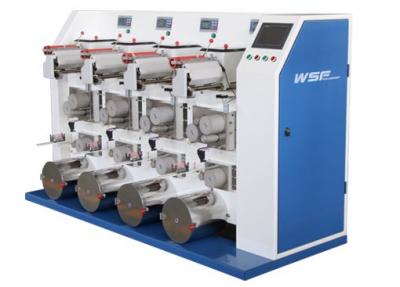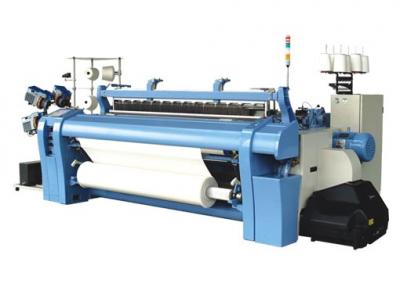1. Quality requirements of dyeing cone
Cone winding requires a very precise yarn layer, which can produce cone winding with controllable density for dyeing. The slack cone has the best liquid permeability in the dyeing process, and its inner and outer yarn density is completely uniform. The requirement of slack winding is not that the looser the better. The basic point is that the density is uniform. According to the general density design requirements of dyeing experience, 0.35g/cm3 is the center, and 0.38-0.40g/cm3 is suitable.
2. Factors affecting the density of bobbin and control methods
The slack cone is very strict with the process requirements. In order to produce slack cone that meets the dyeing requirements, first of all, a large number of experimental data should be used for statistical analysis. Starting from the main factors that affect the slack roll packaging, it is necessary to modify it one by one. Accumulate some experience, and optimize the process according to the requirements of production varieties and dyeing to achieve the purpose of quality control.
The main factors that affect the slack winding are: speed, arm pressure, tension, overfeeding, cross angle, temperature and humidity.
(1)Winding speed: theoretically, the winding speed of the bobbin changes with the winding radius of the bobbin, and the change of the winding speed directly causes the fluctuation of the winding tension, which will affect the forming quality of the bobbin and the mechanical and physical properties of the yarn. If the tension of the outer layer yarn is greater than that of the inner layer yarn, it is easy to produce the phenomenon that the outer layer yarn of the bobbin extrudes the inner layer yarn thus expanding the edge. If the tension changes too much in the winding process, it will also easily lead to different yarn tension due to different winding tension, which requires minimizing the tension and pressure fluctuations in the winding process. Therefore, in addition to ensuring the constant pressure of the bobbin, ensuring the relative stability of the winding speed is an important measure to control the tension fluctuation. At present, the linear speed of 800-1000m / min is suitable for slack cone winding machine.
(2)Arm pressure: it is one of the key factors affecting the yarn density. According to the required package density and hardness, the packing pressure on the supporting roller can be adjusted and maintained. With the increase of the diameter of the yarn, the weight of the package increases. At this time, the pneumatic device of the package support adjusts and compensates the transmission pressure on the supporting roller. According to the experience, the pressure of slack cone loading arm is generally 2-3N.
(3)Overfeeding: the purpose of overfeeding is to fully release tension. An overfeed roller overfeeds the yarn before the final draft in the winding process, compensating for the tension change caused by the unwinding of the feeding coil. The overfeeding value can also be controlled by the system, and the maximum overfeeding can reach more than 70% according to the yarn variety.
(4)Tension: an important way to adjust the density of the yarn, mainly adjusted by changing the tension. Generally, the tension device is installed together with a reed, and the pressure on the flange spring is adjusted through the digital control panel to change the tension of the yarn. It has a starting tension and a ending tension. The tension is controlled by the computer terminal, and the consistency of density is controlled by a linear change. Generally, it can be set from several grams to dozens of grams.
(5)Cross angle: the winding mode of
cone yarn can be divided into precision mesh winding, random mode winding and interlayer winding. The high-speed slack cone winding machine generally adopts precise winding, and other methods can also be used for winding. The cross angle is expressed in degrees, which represents the half angle of the winding of the yarn on the cone. The higher the degree is, the better the unwinding is. But the guide wire speed is also higher. It is recommended to use the middle value. Precision winding has a constant number of winding, and its cross angle is variable. It is characterized by regular and accurate layering of the yarn on the cone, higher winding speed, higher unwinding speed, limited production diameter of the cone, and small difference in the inner and outer layer density of the cone. The cross angle of the precise winding is variable, which makes it convenient for us to set the left and right soft edge table. It is also one of the key technologies for slack cone winding to meet the needs of yarn cone dyeing. In order to achieve the requirements of dyeing, we can also set the taper table to produce a perfect cone. In actual production, we only need to choose winding mode, soft edge table and taper table in the computer.
(6) Temperature and humidity: for slack cone winding, the requirement on temperature and humidity is high. Small changes in temperature and humidity will affect the density and forming of the yarn. This requires a good production environment to control the temperature and humidity changes. Generally, the temperature and humidity should be controlled at about 70%.








 +86-575-86333303
+86-575-86333303  sales@wsftex.com
sales@wsftex.com
 Rifa Road, Nanyan High-tech Zone, Xinchang, Zhejiang, China
Rifa Road, Nanyan High-tech Zone, Xinchang, Zhejiang, China